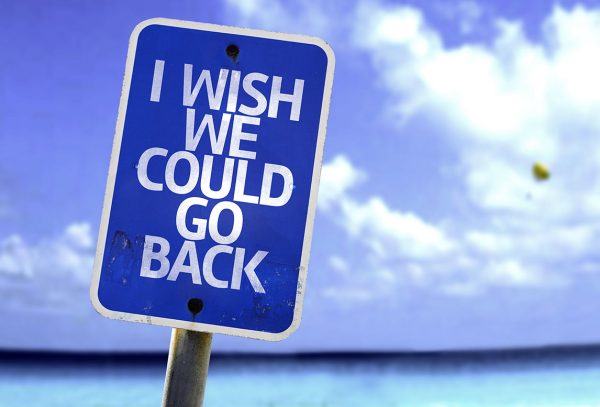Flashbacks are defined as a scene or piece of a scene from a past time that is interjected into an ongoing story. Flashbacks in fiction are usually presented as a memory of the point of view character, and many writers seem quite fond of adding them to their books. The problem with flashbacks is that they can pull the reader out of the moment and thus the story.
 Because of that, I always tell my writing students to use flashbacks in fiction with caution and to make 100% sure the flashback actually serves the story and isn’t just you (the author) dumping backstory that you think the reader needs or that you want to tell them.
Because of that, I always tell my writing students to use flashbacks in fiction with caution and to make 100% sure the flashback actually serves the story and isn’t just you (the author) dumping backstory that you think the reader needs or that you want to tell them.
Actually, I’ll go further than that. If you are using flashbacks, try cutting them all out. See how the story reads. Does it still make sense? How is the flow? How about pace? My guess is the flow and pace will both be better without the jumps back and forth in time. And because of that, the story will also make more sense. Forcing the reader to acclimate himself over and over to what point in time he is at in your book causes him to think.
You don’t want your reader thinking. You want your reader experiencing.
If you just aren’t ready to let go of those flashes back in time, here are a few tips to help make the transition easier for your reader.
First, some types of flashbacks in fiction:
1.) Memory:

Works best if you keep them short.
-One or two sentences is usually enough. Avoid big info dump all in one place with a giant multi-page flashback.
2.) Parallel Stories/Full Scenes:
-Be consistent with these so reader comes to expect the next one.
-Make sure you flag the flashback in some way so the reader knows entering a different time.
3.) Diary/Letter excerpts:
-Can be cliche, but can also be a strong element for the right story.
4.) Dreams:
-Can read as contrived and an obvious attempt by the author to relay infor
mation. Use with care.
5.) The present-day starts with the body of the story ALL in flashback, either working up to present day end or jumping to present day end:
– Told as if the character is telling a story from their past. Easy to do very poorly. The “let me tell you a story” technique.
You know what type of flashback you want to use, is that enough?
No. To make the reading experience smooth and to keep the reader from getting lost in time, you have to alert them that you are moving into a flashback.
Ways to alert the reader that he is in or is going into a flashback in fiction:
1.) Trigger with sense or emotion:
-The smell of cookies, feel of silk, or the crash of a glass breaking against a wall
2.) Timestamp:
– 1895, New England
3.) Change in tense from past to past perfect for the first couple of sentences. (had)
Other things to consider with flashbacks in fiction:
1.) Let reader get established in the main story before moving into a flashback.
2.) Don’t hop too much or too quickly between flashback and the main story.
3.) Do you need this flashback, really? What is its purpose to the story the reader is reading?
Finally, ask yourself, does this flashback serve the main plot? How does it move that story along? If the answer is, it doesn’t, or it actually slows things down, cut the flashback. Your readers will thank you.
~~~

Lori Devoti is the author of paranormal romance, urban fantasy and young adult fiction. Under the name Rae Davies, she writes the USA Today Bestselling Dusty Deals Mystery series. Check our her books at www.LoriDevoti.com and RaeDavies.com. Looking for help with your writing? Lori also does developmental editing and critiques for other authors and publishers. See our Editorial Services page for contact information and pricing. Or check out Lori’s classes at the Continuing Studies Department of the University of Wisconsin.

Enjoyed this post. Yes, I hate the “start at the present, then jump back several years and work your way back to the beginning of the book” thing. Not sure why, I think I hate prequels for the same reason. I don’t mind a a little scene within a scene flashback if it is short. I also don’t mind clear date stamped chapters, if they are really interesting.
I would agree with you when the flashbacks distract. However, my novel, “Tarnished Brass Curtain: A Novel of Vietnam” is a frame story, taking place in seven days, with flashbacks (each a chapter) as much as six months back providing motivation for the current action. I lead into the flashback with the final line of the chapter before it. It must have worked because my novel was a finalist (co-winner) of the 2011 National Independent Press Award for Excellence in the military fiction category. But as I said, I do agree with you on the difficulty of making flashbacks effective.
I should have been born in Victorian times, when readers were accustomed to stories begining with prologues and first chapters which set the scene for the main storyline. But most modern readers don’t like flashbacks. They prefer to be dumped in the middle of the action, with only brief references to the past which has affected/created the present. I obviously need to bring myself up to date! But then, I’m 72, began reading when the longer form was the norm, and was patient and interested to learn the pertinent facts which happen to dwell in the past.
Of course, I may be simply lazy!
i’m a beginning writer and i need help i have started my book with a present day then i jumped back 10 years to lead up to that point. i have had some of my friends read it and they liked it so far but i need help to see if it was a good move on my part.